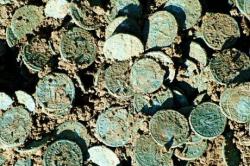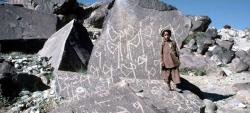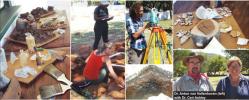INSTITUT SUPERIEUR D'ANTHROPOLOGIE
INSTITUTE OF ANTHROPOLOGY
ONLINE COURSES / COURS A DISTANCE
INSCRIPTION 2012 / Session III : Juillet 2012
REGISTRATION 2012 / Term III : July 2012
FRANCE –  L'Isle-Jourdain - Découvertes il y a bientôt six mois dans un champ, les milliers de pièces de monnaie en bronze sont au centre d'études pour définir qui sont leur(s) propriétaire(s). Le nombre de pièces demeure tout simplement inconnu et incroyablement important. Le trésor en pièces de bronze, frappées entre 290 et 310 de notre ère à Rome, Londres, Lyon, Carthage ou Trèves (Allemagne), selon les premières expertises, et contenu dans trois amphores, est « l'un des plus beaux jamais retrouvés pour cette période en France, voire en Europe », rappelle aujourd'hui Michel Vaginay, conservateur régional de l'archéologie en Midi-Pyrénées. C'était il y a près de six mois. En toute discrétion, les services de la Drac (1) avaient alors déterré les trois fameuses amphores contenant plusieurs milliers de pièces en bronze, dans ce qui est aujourd'hui une vaste parcelle agricole à flanc de coteau, sur la commune de L'Isle-Jourdain. Quelques semaines plus tôt, deux amateurs d'histoire avaient déniché quelques dizaines de pièces remontées à la surface, grâce aux labours. Leur alerte avait permis de déclencher les fouilles. Les premières études en laboratoire sont en cours sur les premières pièces, celles découvertes à la surface et d'autres retrouvées près des amphores. Un premier échantillonnage. « Mais le nettoyage étant très onéreux, nous devrons attendre de connaître les statuts de propriété, avant de nous pencher sur les autres pièces », reprend Michel Vaginay. Et il faudra plusieurs années, encore, avant qu'elles ne livrent tous leurs secrets.
L'Isle-Jourdain - Découvertes il y a bientôt six mois dans un champ, les milliers de pièces de monnaie en bronze sont au centre d'études pour définir qui sont leur(s) propriétaire(s). Le nombre de pièces demeure tout simplement inconnu et incroyablement important. Le trésor en pièces de bronze, frappées entre 290 et 310 de notre ère à Rome, Londres, Lyon, Carthage ou Trèves (Allemagne), selon les premières expertises, et contenu dans trois amphores, est « l'un des plus beaux jamais retrouvés pour cette période en France, voire en Europe », rappelle aujourd'hui Michel Vaginay, conservateur régional de l'archéologie en Midi-Pyrénées. C'était il y a près de six mois. En toute discrétion, les services de la Drac (1) avaient alors déterré les trois fameuses amphores contenant plusieurs milliers de pièces en bronze, dans ce qui est aujourd'hui une vaste parcelle agricole à flanc de coteau, sur la commune de L'Isle-Jourdain. Quelques semaines plus tôt, deux amateurs d'histoire avaient déniché quelques dizaines de pièces remontées à la surface, grâce aux labours. Leur alerte avait permis de déclencher les fouilles. Les premières études en laboratoire sont en cours sur les premières pièces, celles découvertes à la surface et d'autres retrouvées près des amphores. Un premier échantillonnage. « Mais le nettoyage étant très onéreux, nous devrons attendre de connaître les statuts de propriété, avant de nous pencher sur les autres pièces », reprend Michel Vaginay. Et il faudra plusieurs années, encore, avant qu'elles ne livrent tous leurs secrets.
http://www.sudouest.fr/2012/04/17/le-tresor-antique-cherche-ses-proprietaires-690190-2461.php
ROYAUME UNI –  Glastonbury Abbey - New research has revealed Glastonbury Abbey was at the forefront of craft production during medieval England playing host to such prominent visitors as King Edward I. The study of the Abbey’s archaeological excavation records has shown the Abbey was created by skilled craftspeople that used raw materials from the earth to build and enhance the monastery. The Abbey was founded in 712 AD, but a fire in 1184 destroyed many of the buildings. After it was rebuilt it became one of the most powerful monasteries in England. Janet Bell, the Abbey’s curator, said: “It was at the cutting edge of craft production. Stone carving, tile making and glass painting were of the highest quality. “The medieval abbey was richly decorated with glass windows, tile pavements, painted and sculpted stone, fine metalwork, textiles and carved wood.” Following the dissolution of the Abbey in 1539 many of the most valuable objects were taken, meaning there are only a few remaining artefacts left behind today. Professor Roberta Gilchrist of the University of Reading and an Abbey trustee, said: “Glastonbury Abbey was one of the earliest and most important monasteries in medieval England. It has attracted archaeological interest from the early 20th century with 34 seasons of excavations taking place.” Professor Gilchrist dismissed the view the archaeology had not revealed much about the Abbey’s history. “The Glastonbury Abbey Excavation Archive Project has proved otherwise by revisiting surviving excavation records and objects and coupling them with new scientific techniques,” she added. Experts working on the project have used the latest techniques to delve deeper into the history of the artefacts found at the Abbey, revealing new information about Anglo-Saxon and medieval technology.
Glastonbury Abbey - New research has revealed Glastonbury Abbey was at the forefront of craft production during medieval England playing host to such prominent visitors as King Edward I. The study of the Abbey’s archaeological excavation records has shown the Abbey was created by skilled craftspeople that used raw materials from the earth to build and enhance the monastery. The Abbey was founded in 712 AD, but a fire in 1184 destroyed many of the buildings. After it was rebuilt it became one of the most powerful monasteries in England. Janet Bell, the Abbey’s curator, said: “It was at the cutting edge of craft production. Stone carving, tile making and glass painting were of the highest quality. “The medieval abbey was richly decorated with glass windows, tile pavements, painted and sculpted stone, fine metalwork, textiles and carved wood.” Following the dissolution of the Abbey in 1539 many of the most valuable objects were taken, meaning there are only a few remaining artefacts left behind today. Professor Roberta Gilchrist of the University of Reading and an Abbey trustee, said: “Glastonbury Abbey was one of the earliest and most important monasteries in medieval England. It has attracted archaeological interest from the early 20th century with 34 seasons of excavations taking place.” Professor Gilchrist dismissed the view the archaeology had not revealed much about the Abbey’s history. “The Glastonbury Abbey Excavation Archive Project has proved otherwise by revisiting surviving excavation records and objects and coupling them with new scientific techniques,” she added. Experts working on the project have used the latest techniques to delve deeper into the history of the artefacts found at the Abbey, revealing new information about Anglo-Saxon and medieval technology.
http://www.thisissomerset.co.uk/Glastonbury-Abbey-forefront-medieval-England/story-15838793-detail/story.html
PAKISTAN –  Khyber Pakhtunkhwa - The Directorate of Archeology and Museums, Khyber Pakhtunkhwa has launched awareness campaign for highlighting the significance of old relics and buildings in the province. The campaign was launched through arranging a guided tour to the Buddhist era remains of Takht Bhai and Jamal Garhi, District Mardan. The Director Archaeology and Museums Khyber Pakhtunkhwa, Dr. Shah Nazar Khan briefed the group of on the purpose and objectives of the guided tour before departure. He said there are number of ancient remains and other historic relics in the province. The Curator Peshawar Museum, Nidaullah Sehrai, while highlighting the importance of the remains of Gandhara civilization at Takht Bhai and Jamal Garhi said several new sites had been discovered after excavation. He particularly briefed the participants about the Ashoka Stupa and its historic background.
Khyber Pakhtunkhwa - The Directorate of Archeology and Museums, Khyber Pakhtunkhwa has launched awareness campaign for highlighting the significance of old relics and buildings in the province. The campaign was launched through arranging a guided tour to the Buddhist era remains of Takht Bhai and Jamal Garhi, District Mardan. The Director Archaeology and Museums Khyber Pakhtunkhwa, Dr. Shah Nazar Khan briefed the group of on the purpose and objectives of the guided tour before departure. He said there are number of ancient remains and other historic relics in the province. The Curator Peshawar Museum, Nidaullah Sehrai, while highlighting the importance of the remains of Gandhara civilization at Takht Bhai and Jamal Garhi said several new sites had been discovered after excavation. He particularly briefed the participants about the Ashoka Stupa and its historic background.
http://dawn.com/2012/04/17/kp-launches-awareness-campaign-on-archeological-sites/
AFRIQUE DU SUD –  Rustenburg - Keen archaeological excavations conducted by Dr. Anton van Vollenhoven, and colleague Dr. Ceri Ashley, led to the recent discovery of historical treasures. A team of archaeologists, geared with state-of-the-art archaeology kits, headed to the Kedar Country Hotel, just outside Rustenburg, built on the historic land surrounding the farm of former South African President Paul Kruger. From 1-6 April 2012, a team of undergraduate students led by Dr. Ceri Ashley from the University of Pretoria slowly removed the soil layers of several portions on the piece of land. The excited team discovered animal bones, ceramics, glass as well as metal artefacts. Speaking to Platinum Weekly, Dr. van Vollenhoven noted that while no financial value can be placed on the findings, they do provide more niceties about the kind of life experienced by people living on the land during the late 1800s to the early 1900s. This was Paul Kruger’s farm, one of the first places where agricultural activities occured in the area.
Rustenburg - Keen archaeological excavations conducted by Dr. Anton van Vollenhoven, and colleague Dr. Ceri Ashley, led to the recent discovery of historical treasures. A team of archaeologists, geared with state-of-the-art archaeology kits, headed to the Kedar Country Hotel, just outside Rustenburg, built on the historic land surrounding the farm of former South African President Paul Kruger. From 1-6 April 2012, a team of undergraduate students led by Dr. Ceri Ashley from the University of Pretoria slowly removed the soil layers of several portions on the piece of land. The excited team discovered animal bones, ceramics, glass as well as metal artefacts. Speaking to Platinum Weekly, Dr. van Vollenhoven noted that while no financial value can be placed on the findings, they do provide more niceties about the kind of life experienced by people living on the land during the late 1800s to the early 1900s. This was Paul Kruger’s farm, one of the first places where agricultural activities occured in the area.
http://www.platinumweekly.co.za/article979.html
PHILIPPINES - Panatag Shoal - The Chinese Embassy in Manila on Tuesday called on the Philippines to immediately pull out of Panatag (Scarborough) Shoal an archaeological vessel conducting research in the disputed territory. Chinese Embassy spokesperson Zhang Hua said the vessel, which Philippine officials earlier said came from Sarangani province, is conducting “illegal salvage archaeology” on an ancient Chinese shipwreck in the shoal. He added that the Chinese government should have been consulted before the archaeological ship was allowed to conduct research in the shoal. China claims Panatag Shoal (Chinese name: Huangyan Island) as part of its territory, saying the country first discovered the territory during the 13th century under the Yuan Dynastry. The Philippines, for its part, uses the United Nations Convention of the Law of the Sea (UNCLOS) as the basis for its claim on the shoal.
http://www.gmanetwork.com/news/story/255208/news/nation/china-wants-phl-archaeological-vessel-out-of-panatag-shoal
FRANCE –  Périgueux - Que va-t-on trouver sous la place de la Clautre, devant la cathédrale Saint-Front ? « Peut-être les traces d'un cimetière », confie Philippe Calmette, archéologue chargé d'opération à l'Institut national de recherches archéologiques préventives (Inrap). Pendant toute la semaine, l'Inrap va « évaluer le potentiel archéologique » qui pourrait se dissimuler sous l'actuel parking. Une première à cet endroit, où l'on trouvait à l'époque médiévale un monastère et d'autres bâtiments.
Périgueux - Que va-t-on trouver sous la place de la Clautre, devant la cathédrale Saint-Front ? « Peut-être les traces d'un cimetière », confie Philippe Calmette, archéologue chargé d'opération à l'Institut national de recherches archéologiques préventives (Inrap). Pendant toute la semaine, l'Inrap va « évaluer le potentiel archéologique » qui pourrait se dissimuler sous l'actuel parking. Une première à cet endroit, où l'on trouvait à l'époque médiévale un monastère et d'autres bâtiments.
http://www.sudouest.fr/2012/04/17/qu-est-ce-qui-se-cache-sous-la-clautre-690112-1980.php